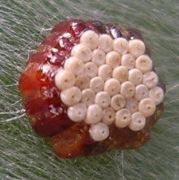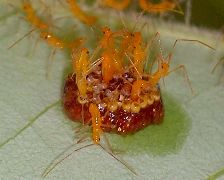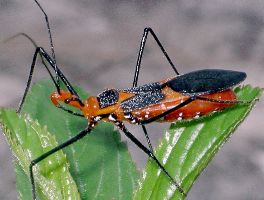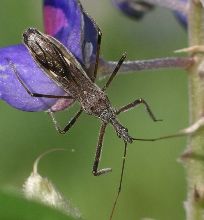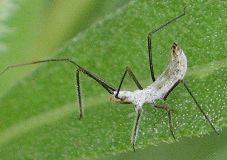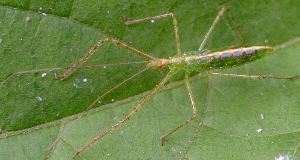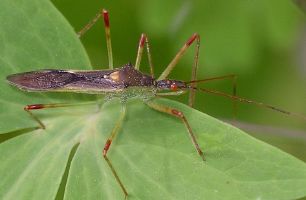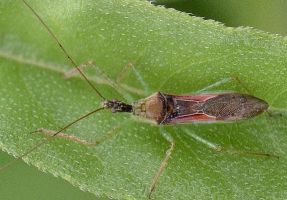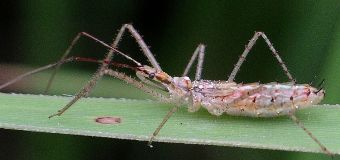
| Reduviidae ~ Assassin Bugs |
page 1 ![]() page 2
page 2
|
The assassin bugs are a diverse group of predators. They range from moderately small to rather large. Most are considered to be beneficial, as they eat caterpillars, leafhoppers, and other plant pests. However, they also eat bees and other pollinators, so they probably are best thought of as neutral. Some of these insects will use their flesh-puncturing beak in defense and can give a painful bite so they should be handled with care. Because assassin bugs feed by sucking out fluids, they take a long time to eat. The result of this is that, unlike predators that chew up their victims and therefore eat quite quickly, they can often be found with prey.
The most common assassin bugs in our area are members of the Zelus genus, which contains seven species. Five of these are found in our area. They are slender, long-legged bugs that are usually found on leaves and flowers, where they hunt by ambush. Length is 10-15 mm. Zelus species can fly and will if frightened, but they usually stay put and rely on their camouflage to hide them from both predators and their prey. They capture prey with their front legs, which are coated with sticky hairs. Zelus eggs are laid on leaves in a small cluster. They have white caps on top. When they hatch, the nymphs disperse very quickly, as they will eat their siblings if given the chance. Assassin bugs of equal size will not attack each other, but if one finds a smaller member of the same species or a freshly molted individual, they are fair game.
The easiest species to recognize is Zelus longipes. Both the nymphs and the adults are bright orange with small white dots and black legs and antennae. The body size can vary quite a bit, depending on how much the insect has eaten, or if it is a female ready to lay eggs. Hungry males can be very thin. I've noticed that Z. longipes has the capability of being the fattest of any species in the genus.
Some Zelus species are notoriously variable in color and Z. tetracanthus is a good example. One way to recognize it is by the four small spines on the back edge of the pronotum. Zelus tetracanthus can be a dusty brown color or a stunning black and white, with anything in between. When I first saw one of the black and white adults, I thought it might have just molted, hence the vivid colors. However, the first one I saw was quite capable of flight and the second one was dining on a planthopper, so they were certainly not teneral. The nymphs are light colored and dusty looking, with black legs that will later become banded to varying degrees.
Another variable species is Zelus luridus. This is a moderately common species here, found about as often as the previous two. The base color of Z. luridus is apple green, and markings on the back may be very dark or rather light. The legs sometimes have dark or red bands on the distal ends of the femurs, but these can often be so light as to be almost invisible. When I've seen mating pairs, the males tend to be the darker ones, with the more pronounced red leg bands. The best feature for recognition is the pair of delicate spines on the rear corners of the pronotum, which are rather long on the light colored individuals and shorter on the dark. The nymphs are a glassy green color but may also have extensive red or tan markings. They are rather long-bodied and smooth in shape.
By far our most common Zelus species is Z. renardii. Like Z. luridus, this is also a green insect with highly variable markings. The pronotum is rather flattened and does not have more than very low spines on the corners. The legs never have distinct bands and the sides of the wings are often a reddish color, but beyond that they can be very light or very dark. The nymphs are a combination of green, tan, and orange, with either the green or the orange predominating, and their legs have many black bands. They have black spines around the edge of their abdomen, which are lacking in Z. luridus nymphs.
I only see Zelus cervicalis occasionally, and it is rather nondescript. However, it doesn't seem to vary much, which helps with identification. The adults are a tan color with brown on their backs. They have a dark stripe between the eye and the antenna on each side of the head. Their shape is quite similar to Z. renardii but the pronotum is noticeably more slender and does not flare as much at the rear end. They appear longer and more narrow in total body proportions. The nymphs are tan with faint markings and they have the same kind of spines around their abdomen as Z. renardii. I'm not sure if they occur on young nymphs, but older ones have the dark stripes on each side of their heads.
There is one other assassin bug that looks similar to Zelus and that is Repipta taurus. This is a small slender black and orange insect with four very long spines on the rear edge of the pronotum. It is not particularly common and is a little smaller than most Zelus individuals.
|
page 1 ![]() page 2
page 2
![]()
